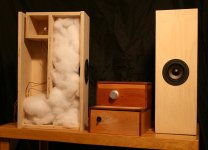With proper bracing and use of curved shapes (like the commercial Tabaq), foam core can take quite a bit of pressure. The curved Kvart and Bolge design is very beautiful and organic, has no parallel walls for a good sound, plus it makes for an easy build with the score and fold technique as only one seam of glue needs to be applied at the closure along the back and two end caps.
You forgot to glue the top of the vent! 😉
Can't wait to read your impressions on the TABAQ.
Foam Core Copy of Kvart and Bolge Tabaq
The curved shape of the Kvart and Bolge design is beautiful and lends itself to foam core construction. This was a fun build that demonstrates the ease of construction using the score and fold technique. I sort of took the liberty of making the profile by guess and by eye to be roughly equivalent to 20 square inches CSA. The length of the Tabaq is about 32in and a sheet of foam core is only 30in so an extender base had to be added. Just as well as it holds the 2.5 square inch CSA vent. I made a very perforated window brace that goes at the midpoint of the tube. Several straight braces are used along the 1/4 and 3/4 span locations to give more stiffness. The curved walls really add rigidity to the structure. Foam was glued around the area behind the driver to ensure back reflections are tamed. Th TL was stuffed with polyfill from the top to about the midpoint (held up by the window brace). A 5-way binding post was added to the bottom. The vent was set at 4in per the plans but this required adjustment after listening and measurement of the impedance. A layer of foam core and latex caulking was used as CLD to damp the front baffle vibration.
Here is the single sheet drawn and scored with a blunt tool. Wall segments are 4.5in baffle, 6in curved wall, and 1.5in segment leading to tail cusp.
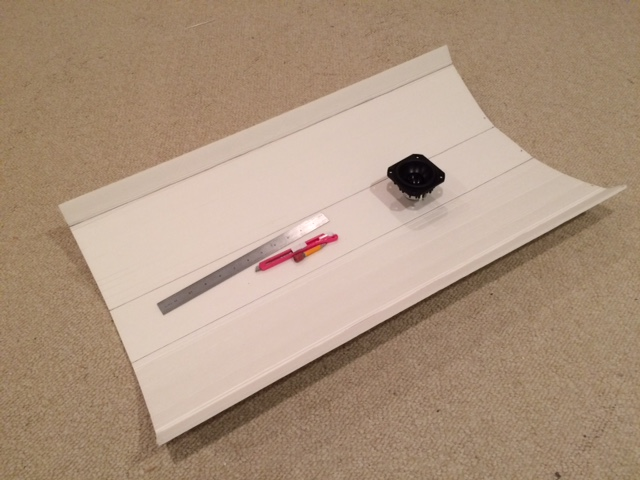
Window brace:
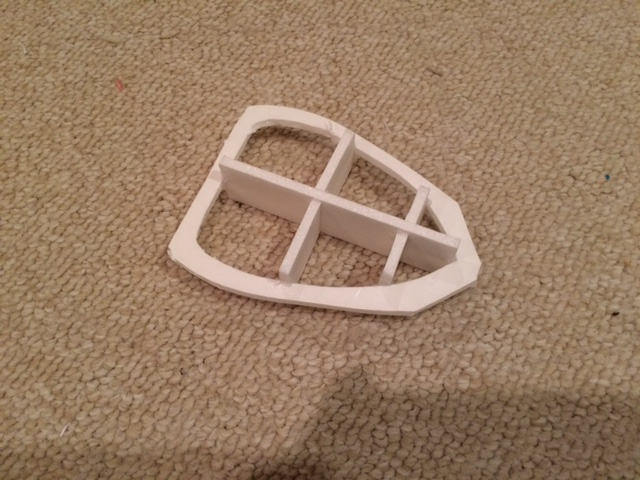
Detail of bracing and base extended before vent was added:
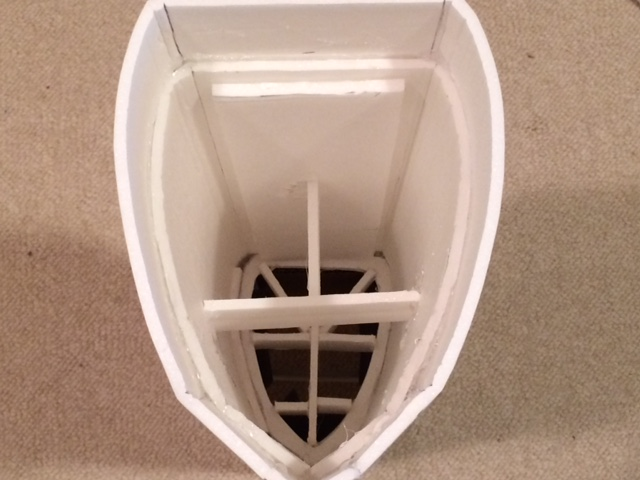
Completed speaker:
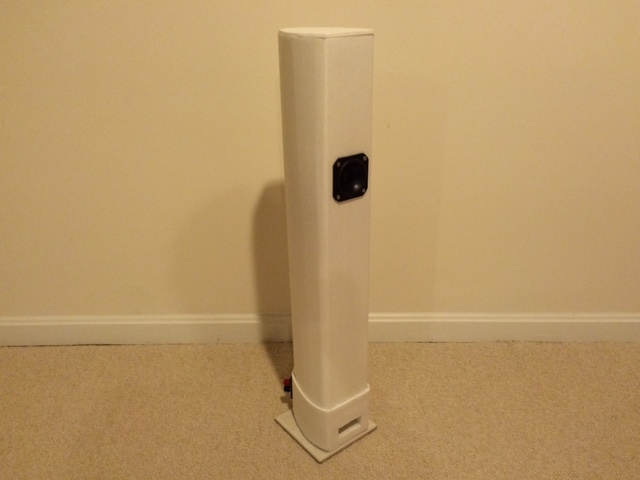
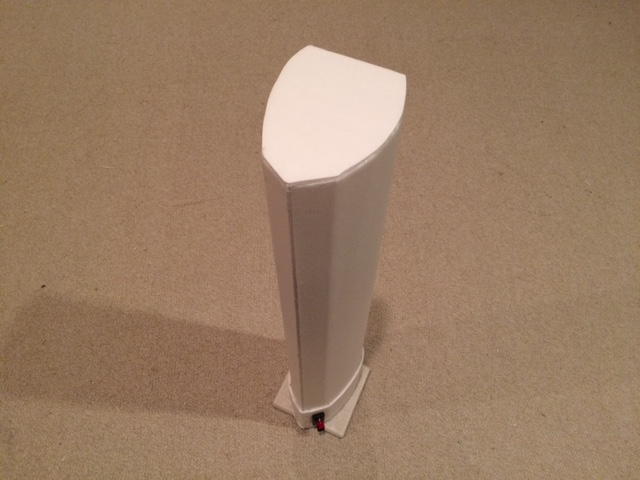
After initial listen, it sounded very bright and measuring the impedance sweep showed that the tuning was at 40Hz. Probably too large a volume created by the curved walls. I trimmed the vent via surgery and cut it down to 1.0 in long which have a tuning frequency of 54Hz. Adding a 1.0mH and 8.2ohm BSC circuit produced this excellent frequency response and distortion curves (taken at 0.5m and 1.41v). Response is very flat and f3 is 49Hz:
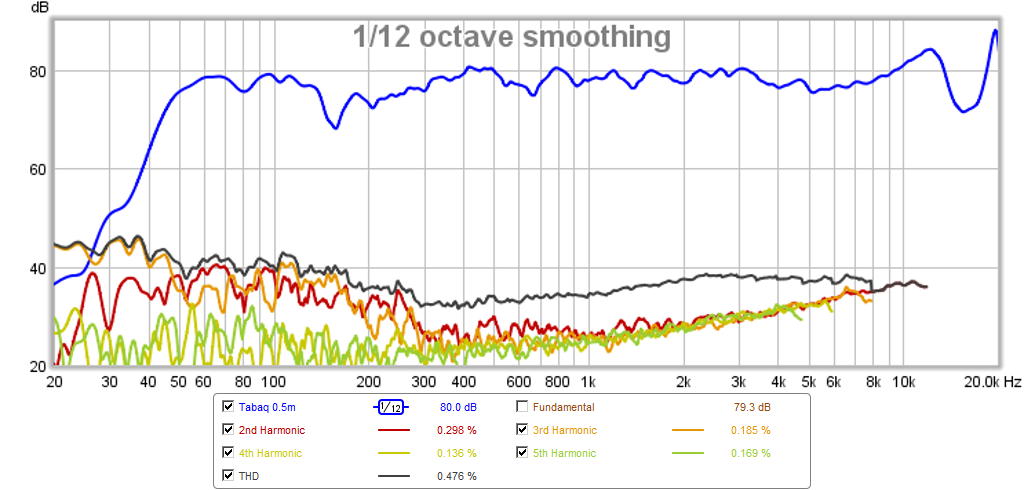
Here is the frequency response shown with a 5ms gate with the phase. Except for the floor bounce and cone breakup, the response is flat within a 5dB band.

Here is impulse and step response. The P830986 is an aluminum cone that rings, but the ring is ultrasonic so doesn't show up as sibillance:
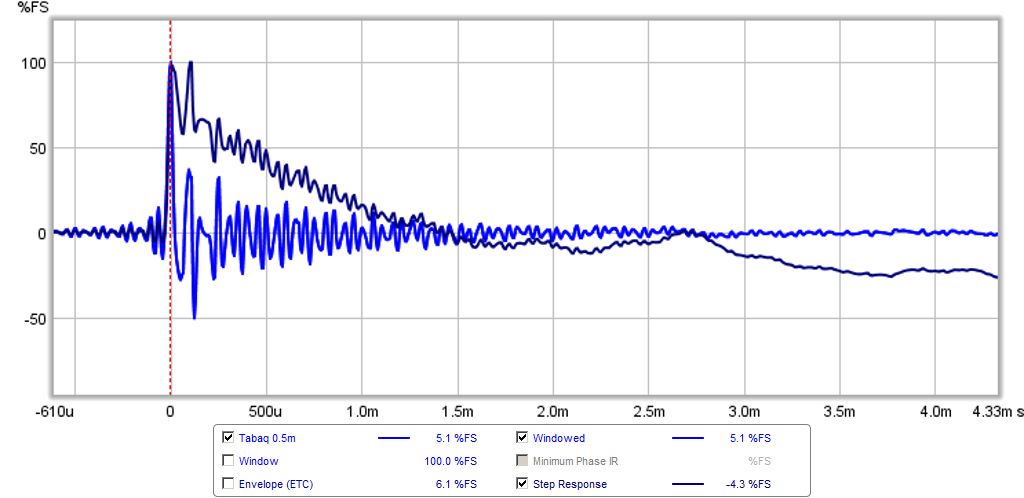
Listening to a few test tracks I have to say this is a great sounding speaker. With BSC it is very balanced and pleasant to listen to. The bass is quite surprising although overall sensitivity was only about 78dB at 2.83v due to the baffle step loss. A highly recommended build - but must have BSC to sound right.
The curved shape of the Kvart and Bolge design is beautiful and lends itself to foam core construction. This was a fun build that demonstrates the ease of construction using the score and fold technique. I sort of took the liberty of making the profile by guess and by eye to be roughly equivalent to 20 square inches CSA. The length of the Tabaq is about 32in and a sheet of foam core is only 30in so an extender base had to be added. Just as well as it holds the 2.5 square inch CSA vent. I made a very perforated window brace that goes at the midpoint of the tube. Several straight braces are used along the 1/4 and 3/4 span locations to give more stiffness. The curved walls really add rigidity to the structure. Foam was glued around the area behind the driver to ensure back reflections are tamed. Th TL was stuffed with polyfill from the top to about the midpoint (held up by the window brace). A 5-way binding post was added to the bottom. The vent was set at 4in per the plans but this required adjustment after listening and measurement of the impedance. A layer of foam core and latex caulking was used as CLD to damp the front baffle vibration.
Here is the single sheet drawn and scored with a blunt tool. Wall segments are 4.5in baffle, 6in curved wall, and 1.5in segment leading to tail cusp.

Window brace:

Detail of bracing and base extended before vent was added:

Completed speaker:


After initial listen, it sounded very bright and measuring the impedance sweep showed that the tuning was at 40Hz. Probably too large a volume created by the curved walls. I trimmed the vent via surgery and cut it down to 1.0 in long which have a tuning frequency of 54Hz. Adding a 1.0mH and 8.2ohm BSC circuit produced this excellent frequency response and distortion curves (taken at 0.5m and 1.41v). Response is very flat and f3 is 49Hz:

Here is the frequency response shown with a 5ms gate with the phase. Except for the floor bounce and cone breakup, the response is flat within a 5dB band.

Here is impulse and step response. The P830986 is an aluminum cone that rings, but the ring is ultrasonic so doesn't show up as sibillance:

Listening to a few test tracks I have to say this is a great sounding speaker. With BSC it is very balanced and pleasant to listen to. The bass is quite surprising although overall sensitivity was only about 78dB at 2.83v due to the baffle step loss. A highly recommended build - but must have BSC to sound right.
Attachments
-
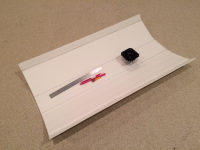 Tabaq-p830986-build-1.png406.8 KB · Views: 3,423
Tabaq-p830986-build-1.png406.8 KB · Views: 3,423 -
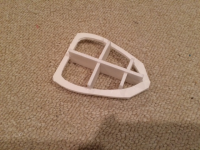 Tabaq-p830986-build-2.png483.1 KB · Views: 3,032
Tabaq-p830986-build-2.png483.1 KB · Views: 3,032 -
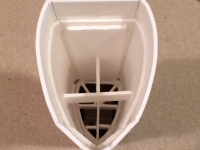 Tabaq-p830986-build-3.png361.7 KB · Views: 3,911
Tabaq-p830986-build-3.png361.7 KB · Views: 3,911 -
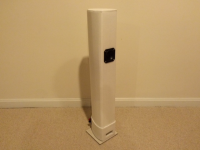 Tabaq-p830986-build-4.png306.1 KB · Views: 4,331
Tabaq-p830986-build-4.png306.1 KB · Views: 4,331 -
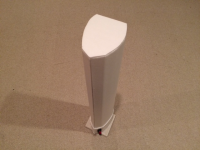 Tabaq-p830986-build-5.png401.4 KB · Views: 2,959
Tabaq-p830986-build-5.png401.4 KB · Views: 2,959 -
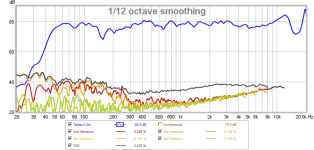 tabaq-p830986-hd.png142.6 KB · Views: 4,368
tabaq-p830986-hd.png142.6 KB · Views: 4,368 -
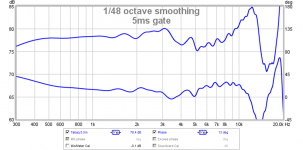 tabaq-p830986-gated-5ms.png76.5 KB · Views: 2,359
tabaq-p830986-gated-5ms.png76.5 KB · Views: 2,359 -
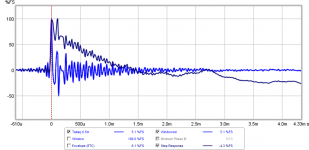 tabaq-p830986-ir-sr.png84 KB · Views: 2,370
tabaq-p830986-ir-sr.png84 KB · Views: 2,370
Last edited:
X, I am glad that you were able to build this speaker that, Bjorn, shared with us. I have built 3 pairs so far as gifts. 2 w/ TB W3-881 NEO, and 1 with the TB W3-2141. They all sounded great, but the last build of the Modified TABAQ TL with the W3-2141 was my favorite! They are wonderful for a small room, and really excel with Vocals & Jazz music.
I don't know if anyone noticed, but for a speaker to measure this flat with no active EQ is rare. The curved edges on the baffle reduce diffraction I am sure. I have not even flush mounted the driver bezel yet. Some improvements around 1k can be had for free there.
The score and fold made this build incredibly easy and rewarding. Besides Bjorn's commercial product - I think this may be the first DIY curved wall Tabaq. Single panel - not 4 like a traditional prism box.
It really works. Thanks Bjorn for a nice design. The P830986 has nice bass and some "etch"'on the high end.
The score and fold made this build incredibly easy and rewarding. Besides Bjorn's commercial product - I think this may be the first DIY curved wall Tabaq. Single panel - not 4 like a traditional prism box.
It really works. Thanks Bjorn for a nice design. The P830986 has nice bass and some "etch"'on the high end.
Here's a link to a commercial speaker, and I want you to take a close look at the cabinet dimensions. This must be a 3" driver on steroids to fit in a cabinet this large? There are no Spec's given, but this is a highly reviewed speaker, with a lot 5 Star/Glowing Write Ups?
Our Products
What do you guy's think? 🙂
Mac
Our Products
What do you guy's think? 🙂
Mac
Here's a link to a commercial speaker, and I want you to take a close look at the cabinet dimensions. This must be a 3" driver on steroids to fit in a cabinet this large? There are no Spec's given, but this is a highly reviewed speaker, with a lot 5 Star/Glowing Write Ups?
Our Products
What do you guy's think? 🙂
Mac
I guess we all know how to pick up a little extra income in our retirement! 😉
That' what I'm talking about! Another example is the Omega's. If we could get our hot little hands on the drivers, then we could build ourselves a pair of $2,500.00 speakers for say, around $300.00? What is really peculiar is the fact there is no support link to buy OEM replacement drivers, unlike a lot of speaker manufacturers like JBL, B&W, ETC? Looks like a conspiracy to keep the DIY guys like us from doing a reverse engineering job to make our own! 🙂
Mac
Mac
Here's a close up of the driver. does it look like the TB W3-1335SB?
http://www.enjoythemusic.com/magazine/equipment/1209/acoustic_technologies_classic_series_close.jpg
Mac
Here's a close up of the driver. does it look like the TB W3-1335SB?
http://www.enjoythemusic.com/magazine/equipment/1209/acoustic_technologies_classic_series_close.jpg
Mac
Sorry, now the link will not work! "Not Authorized" Guess I've been nabbed by the Link Police!!😱
Mac
Sorry, now the link will not work! "Not Authorized" Guess I've been nabbed by the Link Police!!😱
Mac
Me too! 🙄
Just thinking.. how would Visaton W100S play bass range in TBAQ enclosure?
It really is a midbass, even they tell it has a frequency range up to 15000Hz. But maybe with supertweeter?
W 100 S - 8 Ohm
It really is a midbass, even they tell it has a frequency range up to 15000Hz. But maybe with supertweeter?
W 100 S - 8 Ohm
I've read this thread before, and plan to build, hopefully this spring. I plan to use the Dayton RS-100.
Just for my own information, has anyone used the Markaudio CHR-70 in one of these?
Just curious.
I've heard the Markaudio in a BVR a few years ago when they were relatively new and thought is sounded good.
Don't remember seeing any posting referring to them.
John
Just for my own information, has anyone used the Markaudio CHR-70 in one of these?
Just curious.
I've heard the Markaudio in a BVR a few years ago when they were relatively new and thought is sounded good.
Don't remember seeing any posting referring to them.
John
I would probably pull some of the damping from immediately behind / around the driver. Not all of it -but a little. Having a fair amount of material in the immediate vicinity of the driver can end up mass-loading the suspension & cone, preventing it from behaving quite as intended. I suspect most TABAQs have been made with the damping present, so it's unlikely to be issue. Still, it's not a bad idea to ease things off just a little in that region.
Scott, what in your opinion would be the effect of not stuffing densely the area around the drivers? More/less/tighter bass? Or something else?I would probably pull some of the damping from immediately behind / around the driver. Not all of it -but a little. Having a fair amount of material in the immediate vicinity of the driver can end up mass-loading the suspension & cone, preventing it from behaving quite as intended.
You'll likely find the initial impact is on the midrange; as I mentioned, a heavy stuffing density in close proximity to the drive unit can mass-load the suspension & diaphragm under dynamic loads. Since all wideband moving coil drivers produce a large portion of their BW through resonance or flexing of the cone substrate (and any dustcap or secondary cone), a distortion of this and / or the suspension will affect the resonant profile. How much varies with driver & implementation, so there's no hard and fast rule other than to use common sense & avoid cramming stuffing very tightly around the driver. The TABAQ is evidently fine given how many of them are out there, so I'm mainly speaking in general terms -it's just a good practice / ROT to go a little easy in that region.
Last edited:
- Home
- Loudspeakers
- Full Range
- TABAQ TL for Tangband
